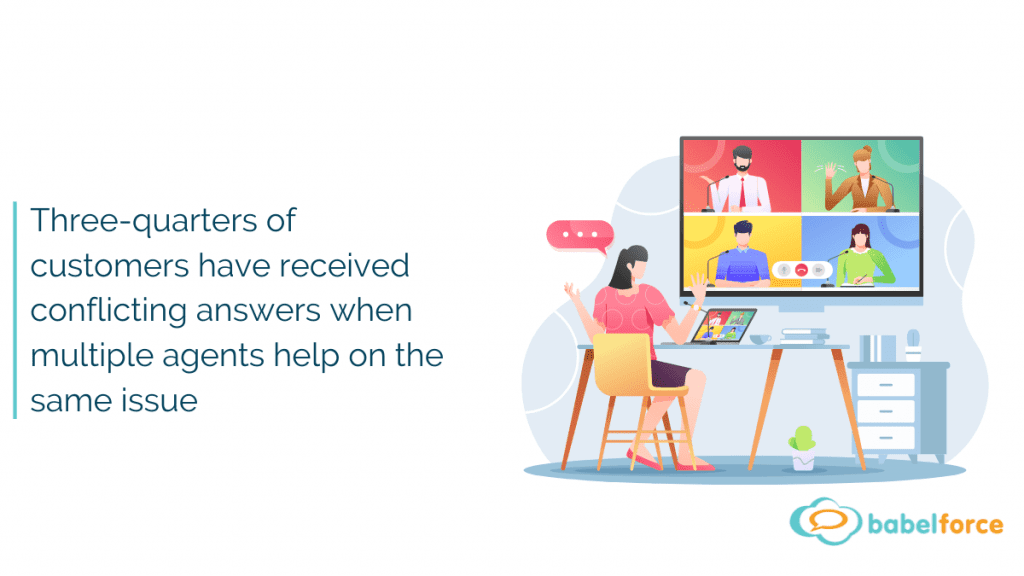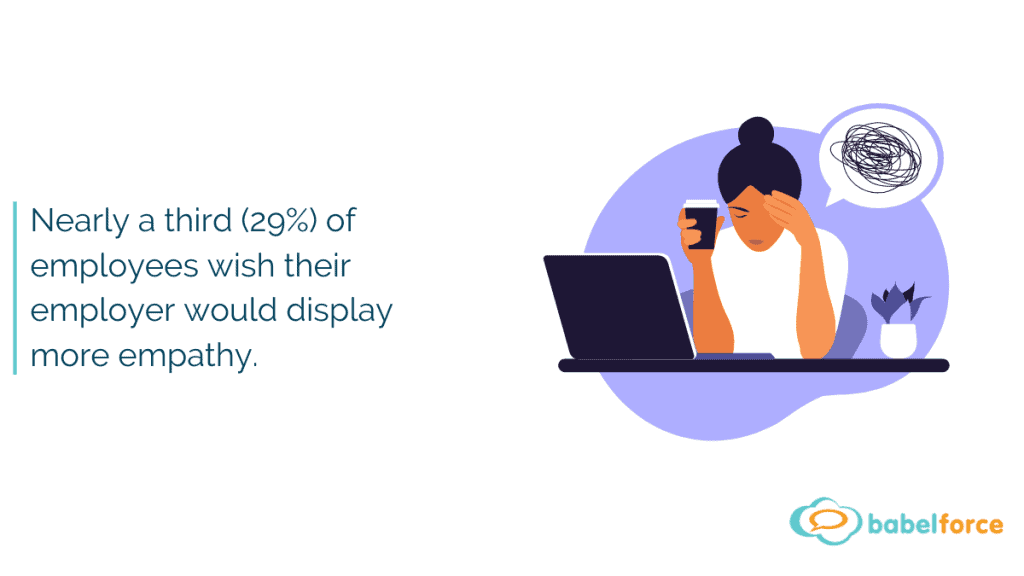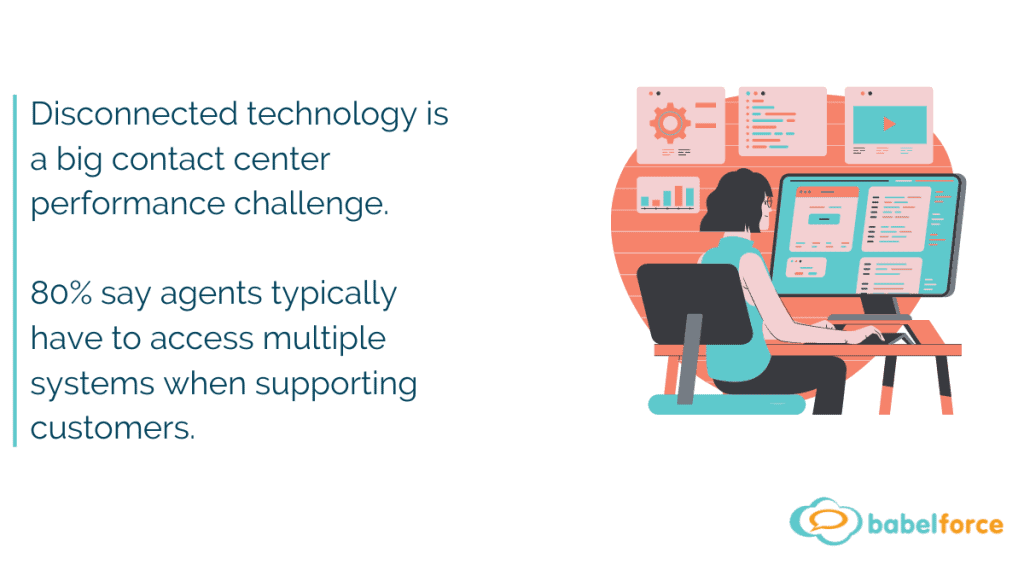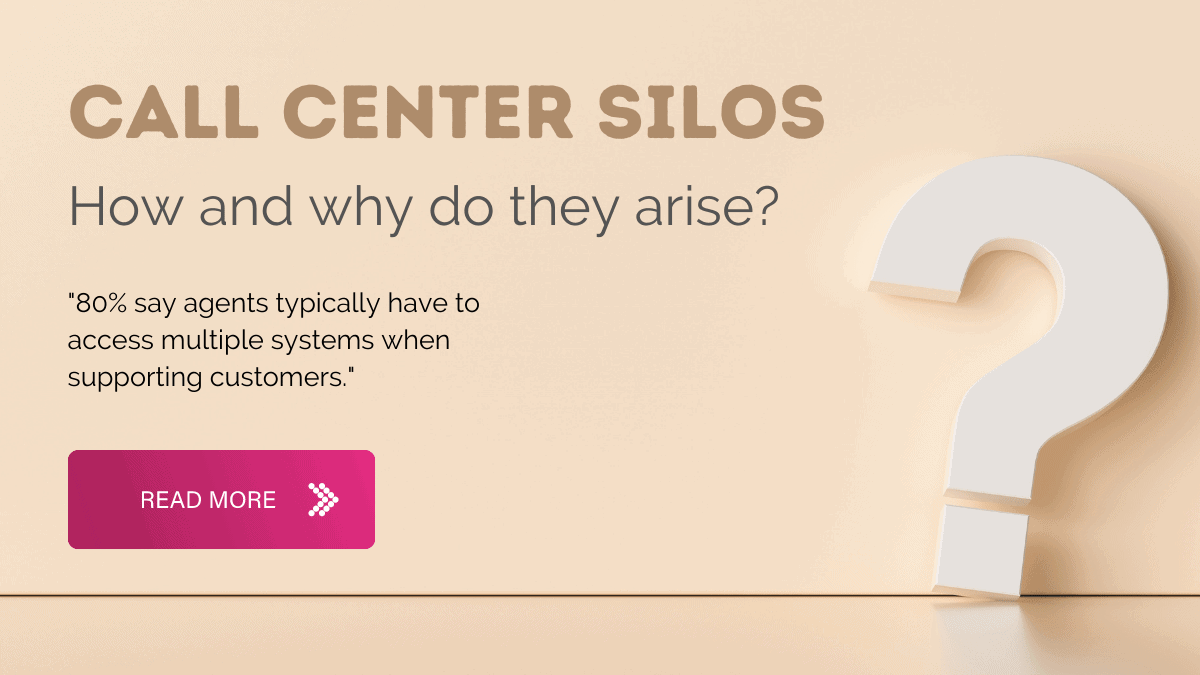In this post:
- What problems do call center silos create?
- What causes call center silos?
- How to solve the call center silo problem
Imagine a customer contacts a call center to try to resolve a billing issue. They speak to a customer service agent, but the agent can’t access the information needed to resolve the problem. They need to speak to the billing department, either leaving the customer on hold or awaiting a callback. The customer is left feeling frustrated, and unnecessary time is lost by agents who must go back and forth between departments to get the info they need.
Given the technological age we live in, this may seem like an antiquated way to work. Unfortunately, it’s still the reality for many call centers. Different departments are operating in call center silos, without efficient communication or data sharing. In a poll by MyCustomer.com, 95% of responding organizations identified a lack of cooperation between departments as one of the biggest barriers to their ability to digitally upgrade the customer contact experience.
What problems do call center silos create?
While poor customer experience may be the most glaring issue created by call center silos, it’s not the only problem they create. Read on to learn more about other issues that can arise.
1. Complicates data analysis
If data is being stored in different formats, according to different standards, then data compilation turns into a nightmare. Some call centers resort to time-consuming manual labor, just to compile and analyze the data held in their silos. This can make measuring some key call center metrics and KPIs close to impossible.
2. Duplicates work
Imagine your call center has a problem experienced by more than one department. Employees are working hard to solve the problem, but thanks to the silo effect, they don’t communicate with each other. The result? More time is wasted by separate teams trying to solve the same problem when they could have been collaborating to reach a resolution much faster.


3. Threatens data integrity
If customer data is held by separate departments, the chances of that data becoming outdated increases over time. Let’s say a customer moves on from your company, and this information is updated in one department, but the message doesn’t get communicated throughout the rest of your organization. Unaware agents continue trying to contact this now ex-customer, causing discontent and a bad reputation. This is just one potential example of the negative situation data silos can create.
4. Wastes resources
Silos lead to both wasted time and wasted money. They are an inefficient way to work, and they cause just as much frustration to agents, who are forced to jump through additional hoops just to complete routine tasks.

What causes call center silos?
Considering how inefficient they are, how do these call center silos develop in the first place? Sometimes a silo situation can creep into a business over time. Humans by nature like routine, and sometimes they can be reluctant to change if they’ve been doing things one way for a long time. This results in some businesses becoming entrenched in silos, making it more difficult to dismantle them. To tackle the problem, it’s important to identify the causes highlighted below.
Technology
Lack of integration between software platforms is by far the leading cause of silos within call centers. Part of the problem is the continued reliance on legacy systems that lack integration capabilities. These systems hold back innovation and prevent companies from upgrading their customer service experience.
Some call center managers may presume it’s too difficult to introduce newer technology, but sometimes delaying it is only postponing the inevitable. Customers generally don’t know a whole lot about APIs, but they will definitely notice when they’re experiencing more frustration with your call center than they are with a competitor.

Culture
While a little competition in the office can be fun and healthy, it can become detrimental to your business if it starts to get out of hand. An office culture of excessive competitiveness can create a situation whereby employees hold back when it comes to sharing information between departments.
Hoarding data to try to gain an advantage over colleagues is ultimately antithetical to the concept of a business, which should rely on collaboration and cooperation. When teams can communicate and work together, they can solve problems more efficiently and push the business forward.
Structure
Most businesses have ambitious growth plans, but if the expansion is left unmanaged without proper planning or oversight, it can lead to the development of silos over time. More employees join, departments expand and more layers are added to the organizational structure. The bigger the company becomes, the more likely it is to experience this silo phenomenon.
How to solve the call center silo problem?
Where there’s a common business problem, someone is bound to develop a solution. Today, there are many modern solutions to the archaic call center silo issue.
One of the easiest ways to permanently rid your business of the dreaded silo is to turn your attention towards the software being used by each department. Do these solutions have the requisite integration capabilities and enable seamless communication between departments? If the answer is no to both, then it might be time for a software upgrade.
Sounds scary? It doesn’t have to be. No-Code integrated call center software can allow different systems to communicate using APIs, without the need for a team of developers. This means the solutions already come with pre-built integration settings ready to go, and you don’t need to be a technology expert to set them up.
What’s more, this software allows for the automation of time-consuming processes that every agent wishes they didn’t have to do. You get all of this, and you don’t have to replace the tech stack you already have. It’s a win-win!
Get rid of call center silos for good
Introducing new software to your call center business doesn’t have to be painful. It will help you to eradicate data silos and the long-term benefits are more than worth it. Your agents will thank you, and so will your customers.
If you’re interested in learning more about integrated software solutions for call centers, check out our article on API integration and how easy it can be.




